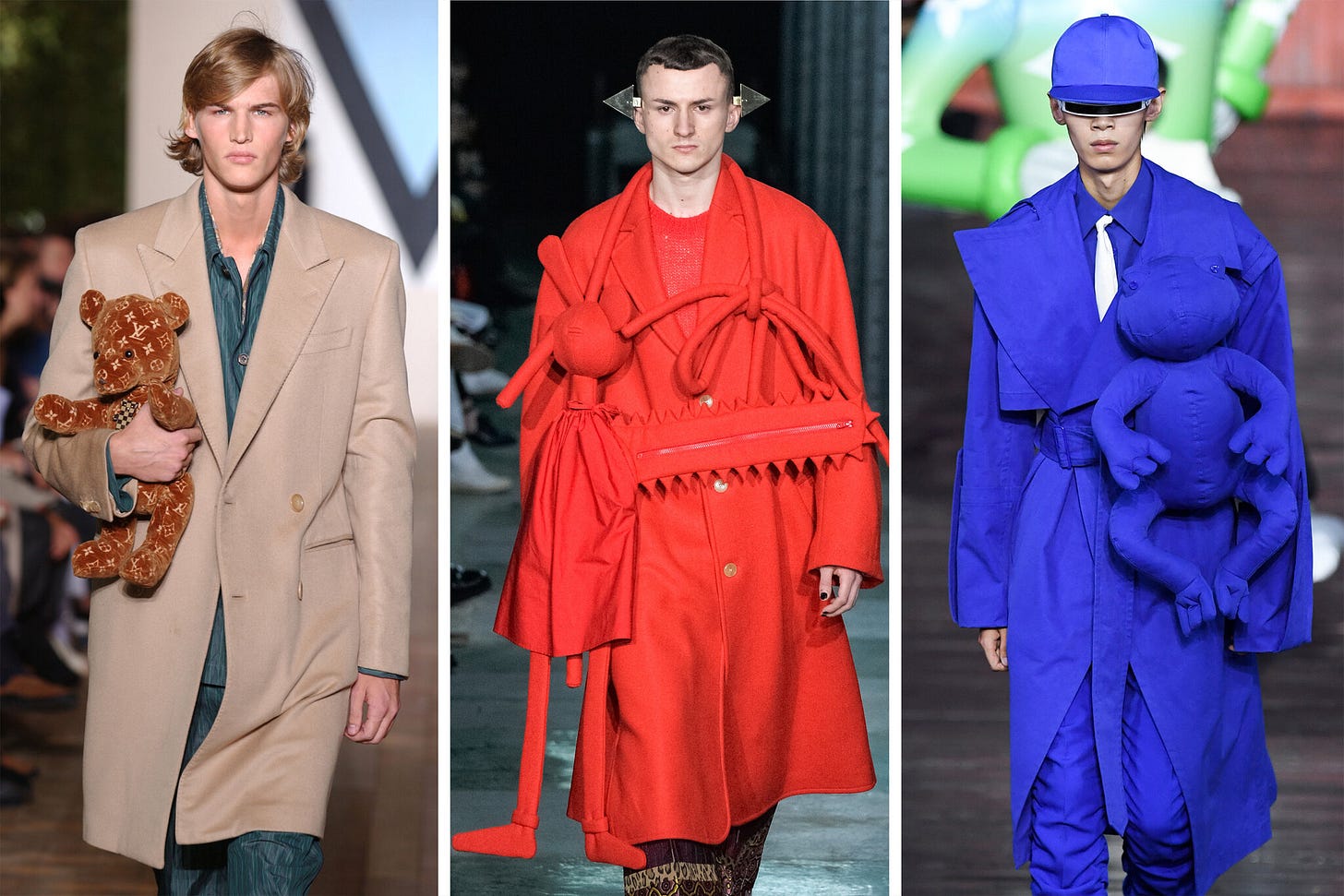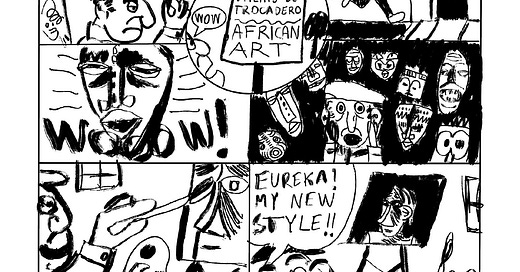What you’re looking for, thinking, crafting, probably already exists.
This seems to be the credo of modern fashion, an industry where innovation no longer seems to pay. The old masters begin to retire, new designers wonder if social media’s endless exposure hinders as much as it helps, and the industry churns on in search of new nostalgia. This is the only hope for the desperate, thrashing, somehow successful brands of today.
The status quo is a falsified newness rooted in past glamour, whether it be Galliano by way of Margiela, creative interpretations of Gaultier, or whatever interpretation of Chloe / Mcqueen / Givenchy / Gucci / Helmut / Ann Demeulemeester / etc. is most chic. The industry needs this nostalgia to remember, and perhaps to plead with buyers to remember, when it functioned. True newness has become unsafe, worse, uninteresting to the status quo.
Those who play the game of joining a mega brand or balancing between e-tailers and fashion week costs often end up burned: Puppets and Puppets fled for London and shuttered ready-to-wear this year, Ludovic de San Sernin was fired after his first Demeulemeester show, and brands with retiring Creative Directors seem more reticent than ever to hire newcomers. In response, many in the indie crowd have rejected “growth“ and remained niche and independent. Consider the moment in 2022 when Louis Vuitton was recruiting a new menswear director, and three of the largest indie names in menswear refused - choosing their own houses over “selling out“. Faith in the system is waning.
Perhaps investment is too - Burberry and Gucci are bleeding cash, Helmut Lang and McQueen are being torn to shreds by critics, and LV and Chloe are so desperate as to attempt the artificial insemination of boho chic back to the frontline. I pray this fails.
To the critics forced to attend, legitimize, and thus congratulate this cyclical parade, it’s hard not to be pessimistic. So, what comes next?
Daniel Lopatin, the musician behind Oneohtrix Point Never has begun defining his approach to music as “Compressionism“
He further explains,
“Compressionists“ play with madness, with that which clashes and defies logic and taste, yet which speak more truly to the state of culture than those who disappear “into the woods“ to find authenticity. The dichotomy in Lopatin’s manifesto is ultimately either to compress or be compressed, to assemble art out of chaos by taking the reigns and influence of that chaos, or potentially let it envelop and consume you. In other words, become a part of the algorithm, or become your own algorithm of unique inputs. “Compressionism” is a new assemblage, a new artistic survivalism.
Fashion, by contrast, has entered a moment defined both by noise and endless irrelevant cultural crossover in spite of the aesthetics of “quiet luxury“. The end of the pandemic brought with it new fantasies of utility, ease, and timelessness. “Quiet“ pieces are meant to feel familiar yet untraceable, perfect without definitive reason, recognizably innocuous. Fashion’s “compressionists” are therefore notably sidelined from dominant sales and focus.
The cultural barrage of “compressionism“ was more in step with the fashion’s flirtation with streetwear in the 2010s. Maximalism, new colors, the breakdown of high and low material and design, and challenges to the definition of luxury marked this moments. The “compressionists” were students of Kanye and Virgil Abloh, themselves students of Pharrell and Nigo. It was a class that held creative director roles and started brands, Heron Preston, Alyx, Rhude, Denim Tears, Cactus Plant Flea Market, and A COLD WALL. In this era, a $90 pair of graphic sweatpants could and would make a bigger statement than certain handbags, and no luxury house could produce a more chic rival to a well-chosen Nike. We know this because they tried. The modes of compression blended together at times, sure, but the uniform was one of clashing and harmonious eras, cultures, and aesthetics.
Many collected their paychecks from this era with an aura of disdain. In 2017 Raf Simons said this of the then still rising Virgil Abloh:
Three years later, another Belgian, this time Walter Van Bierendonck criticized Abloh for stealing his designs. He wrote, “It’s very clear that Virgil Abloh is not a designer… He has no language of his own, no vision. He can’t create something of his own season after season and that is painful.” Bierendonck was known for borrowing extensively from African art and costume, and the show he claimed was “copied“ was reported by Abloh to be inspired by his Ghanan roots. Simons is perhaps most famous for his early work which featured literal collage and patchwork, and endless influence from the world of music and fine art.

Abloh was one of fashion’s most prolific and controversial “compressionists“, a multihyphenate who designed using disparate cultural inputs to create a unified if not chaotic output that spoke to modes of consumption, archive, and use. The various reactions to Abloh’s work throughout his career reflect the ways the line between garment and fashion are policed. More so, they reflect the ways in which both “compressionism“ and the delineations of fashion are subtly racialized.
Fashion is a landscape of imitation, but streetwear (Abloh’s original medium and recurring reference point) is an art form that celebrates and exaggerates flips, references, and imitations. In fashion, to admit you have stolen is to degrade yourself. In this sense, we can see these early criticisms of Abloh as a fundamental misunderstanding of his practice, as blatantly racist and hypocritical attempts to define who is allowed to reference/steal/compress, and as illustrative of the politics of “compression”.



For months I’ve been thinking about a 2019 interview System Magazine conducted between Rick Owens and Yohji Yamamoto. It shows two once marginalized, racialized, niche designers discussing the new guard in a tone I’ve read at different moments as condescending, hypocritical, and principled.
Owens’ distinction between old and new is “craft and poetry“ versus “cynicism and calculation”. For Lopatin, there is a considerable difference in synthesizing disparate references to create art and creating work designed to blend or simply reflect culture. In Owens’ dichotomy, both of these practices could be considered “calculating“. So, what is the “poetry“ that makes a Yamamoto garment different than the ordinary?
Rosalind Jana writes for Vogue India on the tendency to refer to fashion as poetry, writing “Though occasionally apt, it often loses any particular clarity of meaning, being easily replaced with its linguistic bedfellows “lyrical” and “romantic”, and applicable to everything from diaphanous dresses and pastels to vaguely studious silhouettes and flamboyant shirts that wouldn't look out of place on Lord Byron or Percy Bysshe Shelley.“ So, when Owens strikes the dichotomy between the “craft and poetry“ of old and a nouveau “cynicism and calculation“, what is he actually referring to? Next to “cynicism“, perhaps he speaks to a lack of earnest design, a reliance on plastic images, and cheapened products for quickening cycles. Ultimately though, the same metaphorical and imaginary “poetry“ of the past can be used to describe the assemblage of compression or any other “poetic“ calculation. There is as much room for poetry in a silk Rick Owens slip as in baggy Adidas track pants. So, is what Owens and Yamamoto see as missing truly “passion or strength“, or is it something more?
When Alexander McQueen and Vivienne Westwood entered the mainstream, Yves Saint Laurent bemoaned the death of couture, the degradation of fashion. Conveniently, Saint Laurent’s critique of the Avant and new guard was also leveled at working-class designers in defense of the monied old designer families. Couture, and fashion, evolved. The promise of fashion’s, or perhaps more generally the garment’s future as art is always challenging to its status quo, no matter how avant.
Compression is not the only road to fashion’s future, but what we can see from this fifteen year cycle of reactionism to this single fashion practice illustrates the limits of how much the internal structure of a system can truly change.
When considering the future of fashion, how new designers experiment and where they move their business, how the larger lumbering beasts of the mainstream falter, and how the aging avant-masters treat their successors, I still cannot help but feel optimistic.
Roland Barthes writes in La Chambre Claire on the photographic concept of the punctum as ‘that accident which pricks me (but also bruises me, is poignant to me).’ In other words, it is the aspect of the photo that cannot be translated into language, it is the site of indescribable reaction. There is no aesthetic distinction as to what the punctum can touch, there is simply the ability to pierce the viewer. What Lopatin crafts is out of the respect and understanding that all aspects of culture and art have the ability to pierce.
What Owens and Yamamoto and even the grouchier critics like Saint Laurent and Simons ultimately seem to defend is the focus on clothing as meaningful, beautiful, and piercing. When we look at clothing for its ability to connect with people and the world, arbitrary categories like “poetic“ or “calculated“ no longer become necessary. Barthes allows us to reframe the issue of the future of clothing as being about the ability to craft affective, challenging, beautiful work - regardless of whether it exists “in fashion“.
The decline of a fashion industry does not mean the decline of powerful garments. If anything, it means opportunities for new modes of design to appear.
Last week, Business of Fashion ran the headline “Will Dover Street Market’s Big Bet on Independent Fashion Pay Off?“. DSM’s new Paris outpost is stocked primarily by the global avant and indie - basically eschewing reliance on any major global fashion house (Balenciaga, Prada, etc.) for its fashion space. What is instead reflected is a group of designers creating small seasons of niche designs. Many of Dover’s stocked designers are semifinalists for the LVMH prize, a roster which, while not diverse, is made up of a large number of designers working in upcycling and sustainable design.
I write in a time in which fashion newness approaches, meaning inevitable generalized haranguing. While we await the next movements of these titans, we can also sit with these new indie groups, with those outside the fashion calendar entirely, and with the optimism that we are not bound to the failure of some. There is always beauty to be found.






I always learn so much reading you!